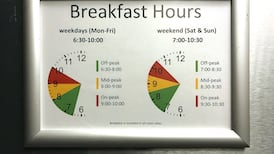In the days after the attack on America, this office received very few calls from readers, not, I believe, because there were fewer mistakes in The Irish Times but rather because priorities had changed, for a short while, at least. Readers overlooked everyday errors and focused instead on the enormity of the calamity.
The Letters Editor, on the other hand, reports a huge increase in post, faxes and e-mail from readers all over the world. The deluge began on the evening of September 12th and has hardly abated since. In an effort to publish a representative sample of reactions to the tragedy, he has allocated far more space to this one topic than to any other in recent years.
But even the mountain of letters to the print edition has been dwarfed by the e-mails sent directly to The Irish Times online. Thousands are still responding daily to the online news polls on the horror. For example, on September 12th, 22,000 readers voted and commented on the question: "Is military retaliation the right response to the atrocities in the US?" Thousands of messages of condolence are also still coming in to the ireland.com noticeboard. These will be sent to the American Embassy in Dublin.
At about 2p.m. on September 11th, journalists and staff from departments all over the building were clustered around television screens in the newsroom, watching the smoke coming from the first tower and discussing what had happened. As the second plane sliced through the second tower, there was a gasp of disbelief and then silence.
But it didn't take long for the instincts of news journalists to take over. Within minutes, the practicalities of how to cover what looked like, even at that early stage, the biggest story of a lifetime, became the priority.
The first question to be asked was: "Do we have our correspondents in place?" Although the news services began sending information almost immediately, it was important to tell this extraordinary story to readers through the eyes and ears of writers they know and trust.
In New York, Conor O'Clery heard a bang, looked out his window and saw a ball of flame and a cloud of black smoke emanating from the first tower. He was an eye-witness to the full horror of what followed. Elaine Lafferty was also in New York and talked to other eye-witnesses. Patrick Smyth was on hand in Washington to report on reaction when a plane plunged into the Pentagon. The priority then moved to the commissioning of analysis and comment.
By now, the most extraordinary images from the most media-alert city in the world had started to arrive to The Irish Times Picture desk.
It was clear that words alone would not suffice to convey the scale of the catastrophe. Events were so incredible that if readers were to believe and accept that they had happened, they would need to see the pictures.
While television screens played and replayed the horrific scenes, the powerful photographs froze those heart-stopping moments and allowed us to ponder on the sheer awfulness of what they depicted. Thus, it was clear a great deal of space should to be allocated to them.
Twelve hours after first impact, eight pages on the most terrifying events most of us have ever known were presented to readers.
While the frantic activity for the print edition was taking place in the newsroom, the breaking news pages in the online edition were being updated constantly. On the day after the attacks, 650,000 of those pages were accessed by readers and the ireland.com website as a whole had its busiest day ever, with over 1.7 million pages accessed in a 24-hour period.
About 48 hours after the events, some of the focus shifted to Afghanistan. Miriam Donohoe, our Asia Correspondent based in Beijing, went to the border between Afghanistan and Pakistan with a brief to report on the geo-political and human situation there.
Some readers expressed concern for her because of the specific and practical concerns that women have to bear in mind in an area of extreme Islamic fundamentalism and the madness that accompanies war. She was instructed to take no risks.
Readers have voiced their appreciation of her courage and her intelligent reporting that has given us an insight into the consequences of retaliation on a people already suffering greatly from a civil war that has been going on for 23 years.
As the days wore on and the coverage continued (so far, we have published more than 100 pages on the traumatic and dramatic events), calls from readers increased, some of them referring to the decision not to publish on the National Day of Mourning.
Technical obstacles made it impossible to distribute the newspaper as usual on the day. It was decided, with reluctance, to withhold publication and to observe the day rather than publish a newspaper which would have been available, at best, to a very small minority of readers. Some readers believed we failed in our responsibility to bring them the news. Others were pleased with the decision.
Readers called about the wide range of opinions that has been published. Some wanted to agree with various writers and others wished to record their often very strong disagreement with certain views.
In the space of 10 minutes one day, I spoke to a caller who applauded a particular article as "a fine piece of common sense" and I received an e-mail which said the same article was "a nasty piece of work". Proof, if proof were needed, that while we are united in our humanity against these terrible crimes, that same humanity can contain endless diversity.
Mary O'Brien is Assistant Readers' Representative of The Irish Times. Readers' Report appears on the first Monday of each Month. Readers may contact the Reader's Representative office at readersrep@irish-times.ie or by phoning 01-675 8000 between 11 a.m. and 5 p.m., Monday to Friday








